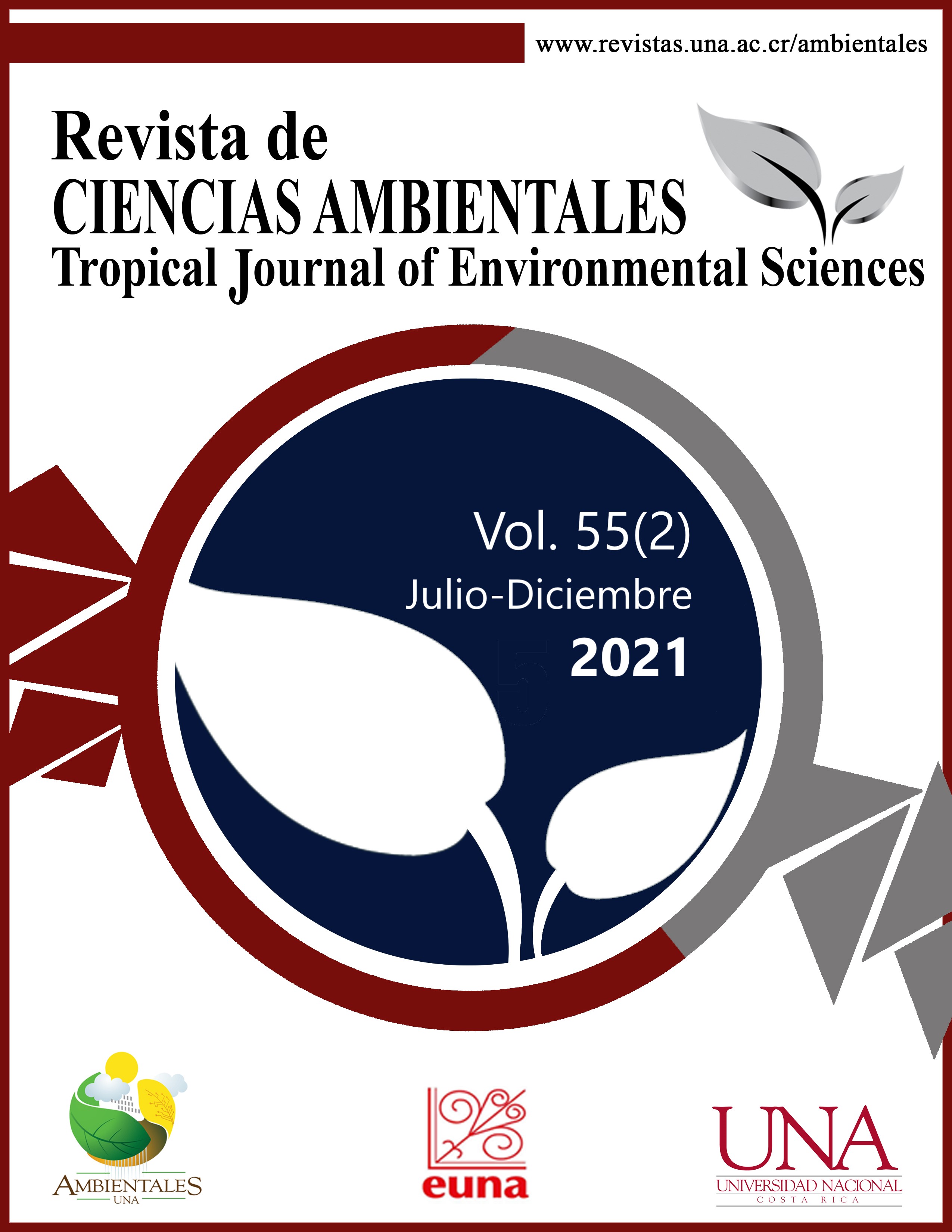Latin America: An Environmental Pollution Haven?
DOI:
https://doi.org/10.15359/rca.55-2.1Keywords:
pollution, income, FDI, environmental Kuznets curve, pollution havenAbstract
[Introduction]: Global environmental degradation is a matter of constant concern that triggered multiple efforts to find its determinants and question the growth style adopted by different countries. [Objective]: Provide empirical evidence of the relationship between pollution, income per person, and foreign direct investment (FDI). [Methodology]: Using an annual panel data of Feasible Generalized Least Squares (FGLS) from 1980 to 2015 in 15 Latin American countries; using the theory of the Environmental Kuznets Curve (EKC) and the Environmental Pollution Haven (EPH). [Results]: It is found that increased levels of FDI are associated with higher pollution, but this relationship is reversed when Latin American economies improve their per capita income above USD 10,380, on average. [Conclusions]: The Environmental Kuznets Curve hypothesis is verified, and there are signs that the Latin American region is considered an Environmental Pollution Haven. These findings add efforts to review policies to attract FDI in the region.
References
Birdsall, N., Wheeler, D. (1993). Trade Policy and Industrial Pollution in Latin America: Where Are the the Pollution Havens? The Journal of Environment y Development, 2(1), 137-149. https://doi.org/10.1177/107049659300200107
Caballero, K., Sánchez, L. (2019). La curva de Kuznets ambiental y su relación con el cambio climático en América Latina y el Caribe: Un análisis de cointegración con panel, 1980-2015. Revista de Economía del Rosario, 22(1), 101-142. https://doi.org/10.12804/revistas.urosario.edu.co/economia/a.7769
Cansino, J., Román-Collado, R., Molina, J. (2019). Quality of Institutions, Technological Progress, and Pollution Havens in Latin America. An Analysis of the Environmental Kuznets Curve Hypothesis. Sustainability. https://www.mdpi.com/2071-1050/11/13/3708/htm. https://doi.org/10.3390/su11133708
CEPAL. (2016). La extracción mundial de materiales se triplicó en cuatro décadas y agudiza el cambio climático y la contaminación atmosférica. https://www.cepal.org/es/comunicados/la-extraccion-mundial-materiales-se-triplico-cuatro-decadas-agudiza-cambio-climatico-la
CEPAL. (2019). Estadísticas e indicadores ambientales. http://interwp.cepal.org/sisgen/Sisgen_MuestraFicha_puntual.asp?indicador=2027yid_estudio=700yid_aplicacion=22yidioma=e
Cole, M. A. (2004). Trade, the pollution haven hypothesis and the environmental Kuznets curve: Examining the linkages. Ecological Economics, 48(1), 71-81. https://doi.org/10.1016/j.ecolecon.2003.09.007
Cole, M. A., Elliot, R. J., Wu, S. (2008). Industrial activity and the environment in China: An industry-level analysis. China Economic Review, 19(3), 393-408. https://doi.org/10.1016/j.chieco.2007.10.003
Correa, F. (2007). Crecimiento económico, desigualdad social y medio ambiente: Evidencia empírica para América Latina. Revista Ingenierías Universidad de Medellín, 6(10), 12-30. http://www.scielo.org.co/scielo.php?script=sci_arttextypid=S1692-33242007000100002
Gómez-Echeverri, L. (1997). Bridges to Sustainability: Business and Government Working Together for a Better Environment. Yale School of Forestry y Environmental Studies Bulletin Series. https://elischolar.library.yale.edu/yale_fes_bulletin/99
Granja, F., Mendonça, A. F., Nogueira, J. M. (2002). Poverty and Environmental Degradation: the Kuznets Environmental Curve for the Brazilian Case. Universidad de Brasilia (267). http://citeseerx.ist.psu.edu/viewdoc/download?doi=10.1.1.725.596yrep=rep1ytype=pdf
Grossman, G. M., Krueger, A. B. (1991). Environmental Impacts of a North American Free Trade Agreement. National Bureau of Economic Research(3914), 1-57. http://doi.org/10.3386/w3914
He, Z., Xu, S., Shen, W., Long, R., Hong, C. (2016). Impact of urbanization on energy related CO2 emission at different development levels: Regional difference in China based on panel estimation. Journal of Cleaner Production, 140, 1719-1730. https://doi.org/10.1016/j.jclepro.2016.08.155
Jaffe, A., Peterson, S. R., Portney, P. (1995). Environmental Regulation and the Competitiveness of U.S. Manufacturing: What Does the Evidence Tell Us? Journal of Economic Literature, 33(1), 132-163. https://www.jstor.org/stable/2728912
Kuznets, S. (1955). Economic Growth and Income Inequality. The American Economic Review, 45(1), 1-28. https://www.jstor.org/stable/1811581
Levinson, A. (2008). Pollution Haven Hypothesis. En The New Palgrave Dictionary of Economics (pp. 1-6). https://doi.org/10.1057/978-1-349-95121-5_2693-1
Lucas, R. E., Wheeler, D., Hettige, H. (1992). Economic Development, Environmental Regulation, and the International Migration of Toxic Industrial Pollution 1960-88. The World Bank: Policy Research Working Paper Series, (1062), 28. http://documents.worldbank.org/curated/en/673921468765926548/pdf/multi-page.pdf
Meadows, D. H., Meadows, D. L., Randers, J., Behrens, W. W. (1972). The Limits to Growth. New York: Other Potomac Associates Books. http://www.donellameadows.org/wp-content/userfiles/Limits-to-Growth-digital-scan-version.pdf
OECD. (1995). Foreign direct investment and the environment: an overview of the literature. Negotiating Group on the Multilateral Agreement on Investment (MAI). https://www.oecd.org/daf/mai/pdf/ng/ng9733r1e.pdf
OECD. (2017). Compare your country (Environmentally related taxes). https://www1.compareyourcountry.org/environmental-taxes/en/0/182/datatable/
ONU. (2019). Cambio climático. https://www.un.org/es/sections/issues-depth/climate-change/index.html
Panayotou, T. (1993). Empirical Tests and Policy Analysis of Environmental Degradation at Different Stages of Economic Development. World Employment Programme Research. doi:10.1007/978-1-349-24245-0_2
Parks, R. W. (1967). Efficient Estimation of a System of Regression Equations when Disturbances are Both Serially and Contemporaneously Correlated. Journal of the American Statistical Association, 62(318), 500-509. https://doi.org/10.2307/2283977
Reed, W., Ye, H. (2011). Which panel data estimator should I use? Applied Economics, 43(8). https://doi.org/10.1080/00036840802600087
Ridzuan, S. (2019). Inequality and the environmental Kuznets curve. Journal of Cleaner Production, 228, 1472-1481. https://doi.org/10.1016/j.jclepro.2019.04.284
Sapkota, P., Bastola, U. (2017). Foreign direct investment, income, and environmental pollution in developing countries: Panel data analysis of Latin America. Energy Economics, 64, 206-212. https://doi.org/10.1016/j.eneco.2017.04.001
Selden, T. M., Song, D. (1994). Environmental Quality and Development: Is There a Kuznets Curve for Air Pollution Emissions? Journal of Environmental Economics and Management, 27(2), 147-162. https://doi.org/10.1006/jeem.1994.1031
Stiglitz, J. E. (2014). Inequality and Environmental Policy. En W. Press (Ed.), In Green Planet Blues: Critical Perspectives on Global Environmental Politics (Vol. 368). https://doi.org/10.4324/9780429322204
Torras, M., Boyce, J. K. (1998). Income, inequality, and pollution: a reassessment of the environmental Kuznets Curve. Ecological Economics, 25(2), 147-160. doi:10.1016/S0921-8009(97)00177-8
Wooldridge, J. M. (2010). Introducción a la econometría: Un enfoque moderno. Cengage Learning Editores.
Zilio, M. (2008). Emisiones de dióxido de carbono en América Latina. Un aporte al estudio del cambio climático. Economía y Sociedad, 133-161. https://www.redalyc.org/pdf/510/51002207.pdf
Published
How to Cite
Issue
Section
License

This work is licensed under a Creative Commons Attribution-NonCommercial-ShareAlike 4.0 International License.



















